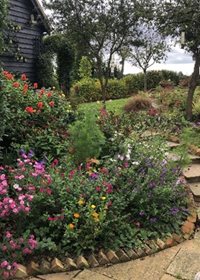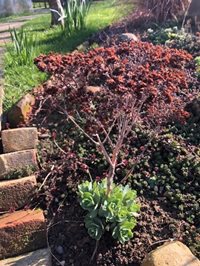
Taking the ache out of gardening by Stuart Dudley; this book caught my eye at a second hand bookshop lately; not only because the book cover was vintage and antique but because I’m always keen to find new or even better, old-fashioned ways of saving time and money in the garden. This book was written in a time when habits were changing and the biggest problem facing the gardener was the lack of “paid help”. Whilst today’s gardening problems focus around climate change and disappearing habitats I think there are still many ways we can take the ache out of gardening whilst solving our 21st century gardening problems.
I adore being out in the garden but as a busy mum of 3 tumultuous teenagers, I find (as I’m sure many people do for many different reasons) that the time I would like to spend in the garden isn’t always the time I have available to me. So, here are some ways that I have found to save time and money in the garden. Perhaps more important than the time and money saving benefits are the environmental benefits and the ways we can attract an abundance of wildlife.
Excitingly, last year was my first with a green house. Lockdown enabled me to spend many hours sowing annual flower seeds, pricking them out then potting them on. Sadly, the success rate of this process was probably around 40%. Meaning precious compost, pots, water and time were wasted. Where are those plants this year? Dead and composted with only their seeds left. I shall not be repeating this mistake again, with the exception of marigolds and nasturtiums which can be directly sown into the ground, I will be focusing on expanding my collection of hardy perennial plants in the garden.
Being a lazy gardener, it is much easier to plant a hardy perennial straight into the ground where it is guaranteed to bloom endlessly year after year, than wasting time, energy & money growing or buying annuals to plant annually. Each year, perennial plants come back healthier and bigger than the last meaning you can split them, creating new plants in your own garden for free and in an environmentally friendly way. Persicaria bistorta or Geranium Rozanne are a good place to start, both spread and have long flowering periods; meaning your garden will have flowers from spring to autumn which is not only lovely to look at but great for attracting pollinating insects too. Healthy growing perennials means there is less space for germinating weeds – and that means less weeding!

My favourite catch phrase from TV gardener Monty Don. For years I have followed this advice religiously only now I’m not chopping down my brown in the autumn but waiting until spring, to chop away any remaining brown stems from my precious perennials. Leaving this job until the spring means I can be lazy and not do it in the autumn and over the winter the wind does some of this job for me.
Some brown dead flowering heads such as the Sedum spectabile ‘Iceberg’ withstand the thrash of the winter winds and really hold their own in the frosty weather, giving you a second flush of beauty. Or even at their very end on a sunny early spring day the browned flower heads sparkle in the early spring sunshine.
Leaving brown flower heads, stems and leaves through the winter months provides extra food and shelter for insects and birds. Having plants covering the soil means it is not left open to wind erosion and can keep its vital nutrients and water trapped within.

Soil health is the foundation of a healthy garden and just like we feed our children to help them grow healthy and strong we need to feed our soil. Composting all your green and brown garden material during the year allows you to have a good supply of home made compost. If this is not enough for your needs you can top it up by buying some peat-free compost or mulch. Spending a few hours in spring mulching your vegetable and flower beds with compost or mulch will save you hours of time later in the year. The compost or mulch will add nutrients to the soil which, for the lazy gardener, means you will not have to waste time money or resources feeding it. Water will evaporate at a slower rate meaning you will have to water less. The compost or mulch will suppress weed growth which again means less weeding time and more time for relaxing in your garden during the warmer months.
As pleasing as vast neatly mown areas of grass with straight lines in look; it takes time, money and energy.
I’m not advocating getting rid of every patch of grass in the garden as it is an integral part of the garden; a place where children and pets play and where people can sit and relax. Grass is certainly preferable to large areas of patios and paving that are impermeable and do not allow rainwater to penetrate the ground – something which has had a big part to play in the increased flooding in recent years. However, there are many gardens that are entirely made up of grass, where hardly any other plants grow. Reducing some larger grassed areas and replacing them with other plants would mean that there is a greater diversity of plants in the garden which would create ecosystems for different insects and other animals to live in.
Two years ago, I dug over our front lawn and scattered it with wild flower seeds saving me 20 mins a week not mowing it. There was less petrol used in my lawnmower meaning some pennies and precious fossil fuel were saved. The advantage is that the front lawn has an ever-changing look to it which attracts a range of insects. Plus at the end of the season when I chopped the long brown stems down and left them for a few days to dry in the sun, my chickens enjoyed the hay that I had made; benefits for many wildlife.
This year I invested some of my saved petrol pennies into buying a few bulk bags of wood chip mulch. I have used this to cover the grass paths that were in between my vegetable beds. Again, I will save time, fuel and money by not mowing here. The wood chip will mean there is less evaporation of water so I will not need to water as much, it will supress unwanted weeds between the beds and create a home for many different micro-organisms which although unseen are vital to good soil health.
When pruning hedges or trees, I make mini piles of branches around the garden. Wood piles are a valuable habitat for mosses, and fungi, as well as many insects. The bird population has increased as the birds feed on the insects that live in the woodpiles they also enjoy perching on the branches which is a pleasure to watch at any time. These wood piles also make good homes and provide shelter for other garden visitors such as toads or hedgehogs which eat slugs and other pests that could damage plants. A recent report The State of Britain’s hedgehogs 2018 (by PTES People’s Trust for Endangered Species and BHPS British Hedgehog Preservation Society) found that half of the UK’s native hedgehogs have been lost from the countryside over the past 2 decades. Providing habitats for these native creatures will help improve their chances of survival.
I hope you will find time to loiter and enjoy your garden as I do in mine and that some of these lazy ways will help you to take the ache out of gardening whilst creating an environmentally and wildlife friendly beautiful garden of your own to relax and unwind in. Remember the crucial part: to take a moment to look around and enjoy the fruits of any labour you have done.
Guest Author: Nicky Sharp
Nicky is a green-fingered mum of three who until recently was a self-taught gardener. Having left her teaching career to support her young family, she has now been able to pursue her passion for horticulture, recently embarking on an RHS course to enhance her expertise